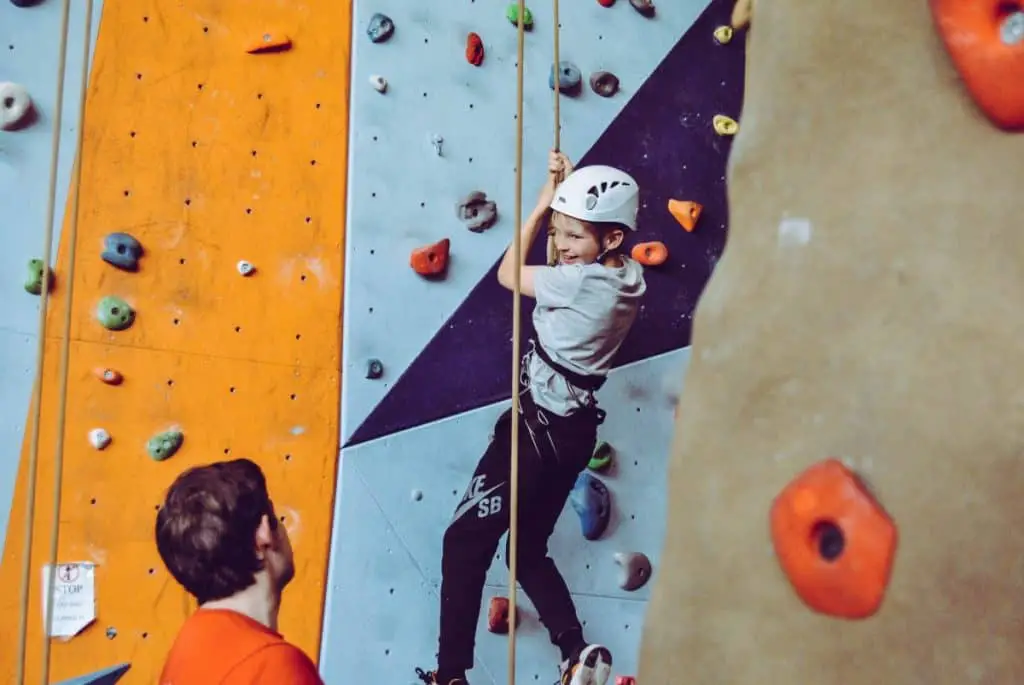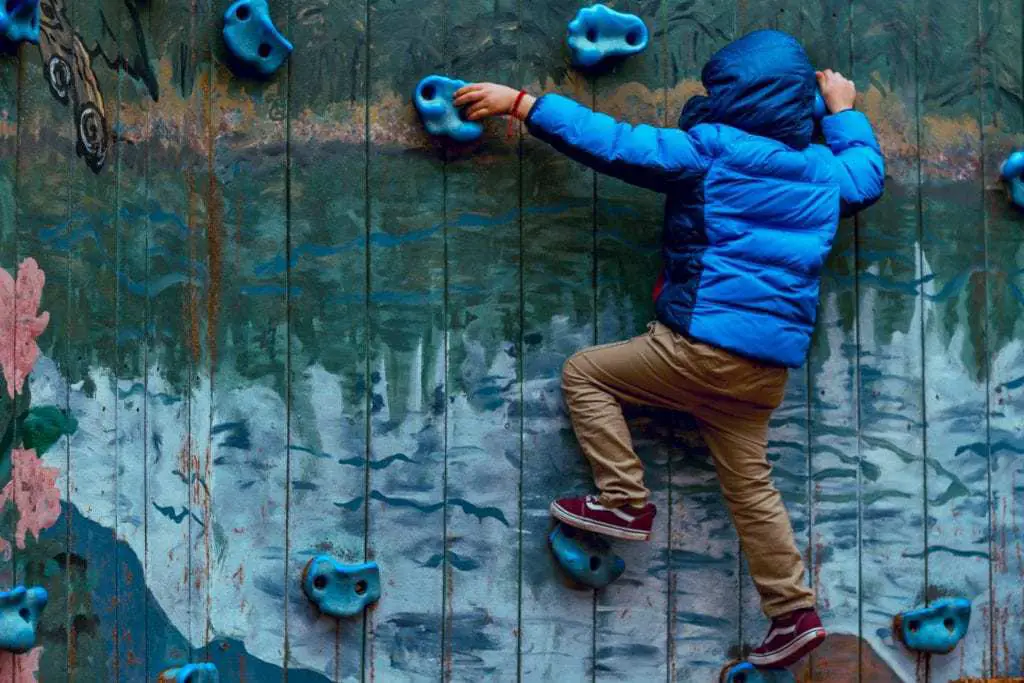
As a parent you may want to introduce your kids to the fantastic sport of rock climbing. You may want them to take advantage of all the amazing benefits rock climbing provides, such as increased confidence, better strength and endurance, improved self-esteem, better decisiveness, enjoyment, and many others. But, when is the right time for your kids to start? In this article, we’re going to look at kids and rock climbing: the right age for them to start, the advantages of early climbing for them, and many other things we think you should know.
So, what age can kids start climbing? Technically speaking, as long as your kid(s) can walk, they can climb. Some rock climbing experts recommend introducing them to this sport when they’re around 4-7 years. This is because they can take instructions well and have developed some problem-solving skills at that age. However, a parent/guardian should be the one to decide based on their physicality. Kids are well-known for being adventurous; you can see them trying to climb the door, the couch, and other surfaces when they’re as young as two years. Note that early age climbing requires a lot of supervision, and they should not climb without the presence of an adult. Studies have shown that climbers below 16 years should not engage in intensive finger strength training.
Page Jumps
- How Old Should a Child be to Start Bouldering?
- How Old Should a Child be to Start Roped Climbing?
- Kids and Toddlers Training Techniques for Climbing
- Science-Backed Mental and Physical Advantages of Getting Your Child into Climbing Early
- Is Climbing Safe for My Kids?
How Old Should a Child be to Start Bouldering?
For those asking what age can kids start bouldering, there are group classes for 3-year-olds and above. Therefore, if your kid is around this age, you can take them to learn more about this sport and enjoy themselves. Note that bouldering is a bit different from roped climbing because it doesn’t require a harness and usually isn’t as high. Climbers use thick padded crash mats to minimize the impact on their bodies when they fall.
However, even if it’s a coached session, there are some things you should teach your kids yourself. The coach to child ratio is usually small; one coach to five kids or more. That’s why you should teach your kids some tips to keep themselves safe in the gym. The first and most important tip is situational awareness. They should be aware of their surroundings and keep looking up to make sure no one is above them. That way, even if a climber falls, he/she won’t fall on them and cause potential injuries.
And while there are thick padded mats to reduce the impact of falling, proper landing is also vital. Your kids should learn how to land safely so that they don’t injure their legs, arms, or head.
Safety responsibility is critical for your kids. Teach them to stay away from risky situations if they don’t feel like everything is right. If you accompany them to the gym, you can also ask the coach or trainer to correct them when you notice mistakes. Bouldering is fun, but safety should be a priority.

How Old Should a Child be to Start Roped Climbing?
There are group classes for 3-year-olds and above in roped climbing gyms as well. However, it would be best to ask your local gym about the minimum age they allow. Various gyms have different minimum ages given by their insurance providers, and therefore, check to avoid any disappointments.
As the name suggests, roped climbing is a type of climbing that uses ropes. Your child also requires several other pieces of essential equipment such as a harness, a climbing helmet, shoes, and chalk bag (however your local gym may rent these out). When purchasing a kid’s harness be sure to get the right one. Kids’ harnesses are almost similar to adult harnesses, but they’re designed to suit a child’s physique. Due to their higher center of gravity, a full-body harness is the most appropriate choice for younger kids, typically 5 years and below.
When it comes to harness’s size, it should be snugly enough, but it should be in such a way that it fits without being easily pulled down. If you’re buying at a physical store, it’s always wise to test it before making the final purchase. The Petzl Simba Full-Body Harness is a great climbing harness for kids.
While kids may prefer to climb barefooted, climbing shoes are important to protect their toes. The chosen shoes should fit properly and be flexible. For the climbing helmet, it should be robust enough to withstand force from all sides. It should also be adjustable so that your child can use it for a long time before he/she fully outgrows it. A chalk bag that easily fits on a belt loop is also essential. That way, your child can dip their hand easily and grab some chalk to dry the hands.
Kids and Toddlers Training Techniques for Climbing
Let them watch videos
The first technique you can use to train your kids about climbing is letting them watch videos. There are lots of bouldering and rock climbing videos on a platform like YouTube, and these can work to help your kids learn the basics. You can also watch these videos with them as you explain the various aspects of climbing such as the equipment used and their purpose. Depending on the video you’re watching, also be sure to explain the featured type of climbing, whether top-roping, bouldering, lead climbing, etc.
Use guidebooks
Apart from videos, another way to train kids on how to climb is using guidebooks. There are lots of guidebooks available for kids, and they can learn the basics they need to know before embarking on this activity. One characteristic that makes guidebooks an excellent choice is that they feature in-depth explanations about different climbing factors. You can also go through these books with your kids to help them understand better. And while purchasing books, make sure they are easy to understand.
Climb as they watch
When kids see the actual task, they understand better. Therefore, hop onto the wall and let watch as you climb. It may even not be you, it can be another person like one of their siblings. Encourage them to pay attention and see how you move from one rock to another. When you’re done, let them try it. Since they’re beginner toddlers, supervise them every step of the way to make sure they stay safe. Being there to guide them is also good because you can point out any mistakes and correct them.
Professional climbing training
If the task of teaching your kids how to climb seems challenging for you, enrol them in your local climbing gym. There are expert climbers here and they train everything, from beginner to advanced skills. Since these professionals most likely have trained lots of other people, they know techniques for faster learning such as:
- Laser chasing – Using laser light to point holds that kids should use to climb depending on the level of difficulty. As they continue to gain skills, expert climbers direct them to holds that are harder to access.
- Elimination – Making the climbing task a little bit challenging by eliminating some holds. Not an actual elimination, but marking them so that the kids can’t use them.
- Toprope racing – Having a climber race to the top as other climbers cheer on. The aim of this technique is making your child climb within the shortest time possible.
- Climbing challenges – This is where kids learn to climb the same route several times but with a different challenge each time. For instance, using one hand the first time, using one leg the second time, etc. These challenges are vital for coordination and endurance.
- Blindfolded climbing – The kid is blindfolded, then the trainer guides him/her to climb by saying out loud directions of the holds.
These are just some of the training techniques that can come in handy to help your kid learn climbing. However, according to a study published on the National Center for Biotechnology Information, climbers below 16 years should not engage in intensive finger strength training. They also should not engage in international bouldering competitions. These recommendations ensure these young climbers aren’t exposed to substantial injuries.
Science-Backed Mental and Physical Advantages of Getting Your Child into Climbing Early
Better problem solving, memory, and concentration
Climbing is one of the best activities for the improvement of cognitive skills. That is according to research by the University of Florida’s Department of Psychology. To conduct this study, the researchers recruited individuals aged between 18 and 59 years. Their memory capacity was tested first, and then they were exposed to various proprioceptive activities such as climbing trees. After the study, these individuals were tested, and they had a whopping 50% increase in memory capacity.
Since memory is crucial especially in school, early climbing for kids is beneficial. And since climbing involves deciding the most suitable routes to talk and being aware of one’s surrounding, kids can also gain better problem solving and concentration skills.
Physical, intellectual and spiritual development
This study published on ResearchGate aimed to justify the importance of learning motor skills for young people. The study which lasted for seven months comprised of 42 young climbers aged 6-7 years, and a group of 21 acting as the control. At the end of the research, these two groups were tested, and the group which participated in rock climbing showed significant physical, intellectual and spiritual improvements. The young climbers were stronger, more flexible, and had better intellectual skills such as problem-solving and creative thinking. With all these improvements, this study proves climbing is advantageous for kids.
Bouldering as a physical fitness activity
This study was aimed at evaluating the physiological impacts of two bouldering types in elementary school students. The students engaged in bouldering activities (traditional and structured), and heart rates were measured after resting and after each activity. While there wasn’t any notable difference between heart rates in traditional and structured bouldering, there was a major difference between resting and each bouldering activity. These results prove that bouldering is a legitimate and acceptable way to improve physical fitness.
Is Climbing Safe for My Kids?
If you’re going to enroll your child in this activity, you may be concerned about its safety. What you need to know is that every sport has its safety risks; the most important thing is staying on top of these risks to make sure nothing wrong happens. For instance, particularly for kids aged 4 and below, they shouldn’t climb without adult supervision. That way, if anything happens the adult can save the situation. Another tip is educating kids on how to stay safe in the gym – either by not engaging in risky actions or being aware of their surroundings. I’ve written a whole article on safety, tips and rules for keeping your children safe while bouldering which you can find here.
You should also note that indoor climbing gyms have thick padded mats to reduce the impact of falling. These pads are tested from time to time to ensure they’re 100% safe to use.
Hopefully, you’ve learned what you needed to know about kids and climbing. It’s very beneficial. And for the people who’ve been asking what age can kids start climbing, as long the child can walk, he/she can start climbing gradually and with strict supervision. The earlier they start, the earlier they can start enjoying the amazing benefits of this fantastic activity.
